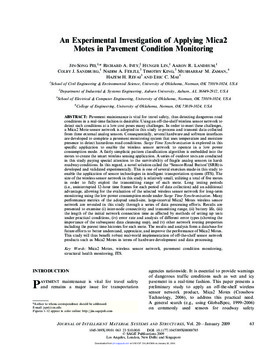| dc.contributor.author | Jin-Song Pei | |
| dc.contributor.author | Richard A. Ivey | |
| dc.contributor.author | Hungjr Lin | |
| dc.contributor.author | Aaron R. Landrum | |
| dc.contributor.author | Colby J. Sandburg | |
| dc.contributor.author | Nadim A. Ferzli | |
| dc.contributor.author | Timothy King | |
| dc.contributor.author | Musharraf M. Zaman | |
| dc.contributor.author | Hazem H. Refai | |
| dc.contributor.author | Eric C. Mai | |
| dc.date.accessioned | 2016-01-14T19:53:21Z | |
| dc.date.accessioned | 2016-03-30T15:32:43Z | |
| dc.date.available | 2016-01-14T19:53:21Z | |
| dc.date.available | 2016-03-30T15:32:43Z | |
| dc.date.issued | 2009-01-01 | |
| dc.identifier.citation | Pei, J.-S., Ivey, R. A., Lin, H., Landrum, A. R., Sandburg, C. J., Ferzli, N. A., . . . Mai, E. C. (2009). An Experimental Investigation of Applying Mica2 Motes in Pavement Condition Monitoring. Journal of Intelligent Material Systems and Structures, 20(1), 63-85. doi: 10.1177/1045389x08088785 | en_US |
| dc.identifier.uri | https://hdl.handle.net/11244/25206 | |
| dc.description.abstract | Pavement maintenance is vital for travel safety, thus detecting dangerous road conditions in a real-time fashion is desirable. Using an off-the-shelf wireless sensor network to detect such conditions at a low cost poses many challenges. In order to meet these challenges, a Mica2 Mote sensor network is adopted in this study to process and transmit data collected from three external analog sensors. Consequentially, several hardware and software interfaces are developed to complete a pavement monitoring system that uses temperature and moisture presence to detect hazardous road conditions. Surge Time Synchronization is explored in this specific application to enable the wireless sensor network to operate in a low power consumption mode. A fairly simplistic pattern classification algorithm is embedded into the motes to create the smart wireless sensing application. A series of outdoor tests are conducted in this study paying special attention to the survivability of fragile analog sensors in harsh roadway conditions. In this regard, a novel solution called the ``Sensor-Road Button''(SRB) is developed and validated experimentally. This is one of several exercises made in this study to enable the application of sensor technologies in intelligent transportation systems (ITS). The size of the wireless sensor network in this study is relatively small, utilizing a total of five motes in order to fully exploit the transmitting range of each mote. Long testing periods (i.e., uninterrupted 12-hour time frames for each period of data collection) add an additional advantage, allowing for the evaluation of the selected wireless sensor network for long-term monitoring using the low power consumption mode under Surge Time Synchronization. Many performance metrics of the adopted small-size, large-interval Mica2 Motes wireless sensor network are revealed in this study through a series of data processing efforts. Results are presented to examine (i) inter-node connectivity and transmitting range, (ii) battery life, (iii) the length of the initial network connection time as affected by methods of setting up tests under practical conditions, (iv) error rate and analysis of different error types (showing the importance of the subsequent data cleansing step), and (v) other network routing properties including the parent time histories for each mote. The results and analysis form a database for future efforts to better understand, appreciate, and improve the performance of Mica2 Motes. This study will thus benefit robust real-world implementation of off-the-shelf sensor network products such as Mica2 Motes in terms of hardware development and data processing. | en_US |
| dc.language.iso | en_US | en_US |
| dc.publisher | Journal of Intelligent Material Systems and Structures | |
| dc.subject | Mica2 Motes | en_US |
| dc.subject | wireless sensor network | en_US |
| dc.subject | pavement condition monitoring | en_US |
| dc.subject | structural health monitoring | en_US |
| dc.subject | ITS. | en_US |
| dc.title | An Experimental Investigation of Applying Mica2 Motes in Pavement Condition Monitoring | en_US |
| dc.type | Research Article | en_US |
| dc.description.peerreview | Yes | en_US |
| dc.description.peerreviewnotes | https://us.sagepub.com/en-us/nam/manuscript-submission-guidelines | en_US |
| dc.identifier.doi | 10.1177/1045389x08088785 | en_US |
| dc.rights.requestable | false | en_US |
